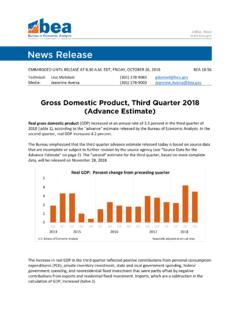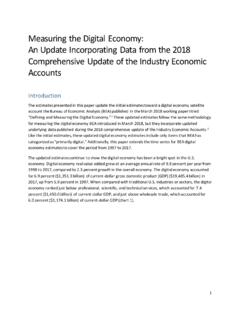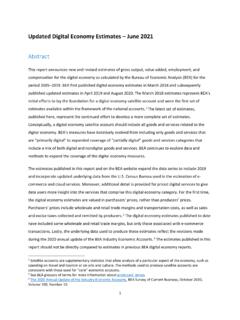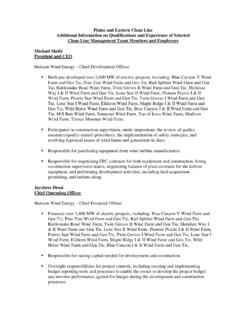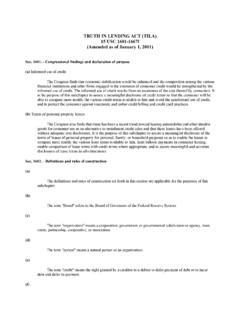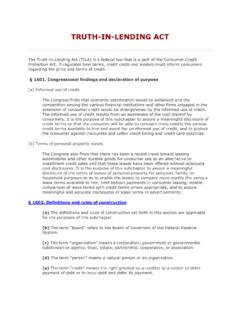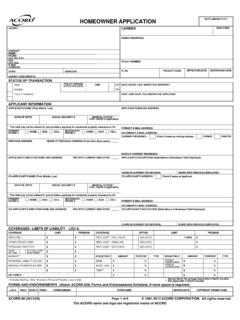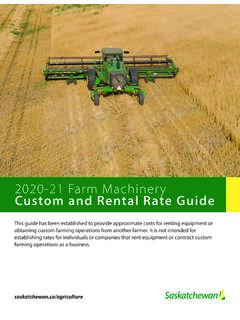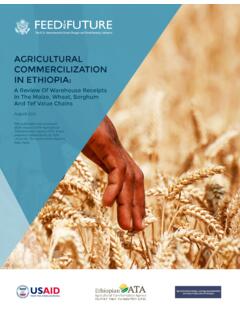Transcription of CHAPTER 5: PERSONAL CONSUMPTION EXPENDITURES …
1 CHAPTER 5: PERSONAL CONSUMPTION EXPENDITURES . CHAPTER 5: PERSONAL CONSUMPTION EXPENDITURES . (Updated: December 2021). Definitions and Concepts Recording in the NIPAs Overview of Source Data and Estimating Methods Benchmark-year estimates Nonbenchmark-year estimates Current quarterly and monthly estimates Quantity and price estimates Table Summary of Methodology for PCE for Goods Table Summary of Methodology for PCE for Services Technical Note: Special Estimates New motor vehicles Net purchases of used motor vehicles Gasoline and other motor fuel Rental of tenant- and owner -occupied nonfarm housing Financial service charges and fees Securities commissions Financial services furnished without payment Life insurance Property and casualty insurance Nonprofit institutions serving households PERSONAL CONSUMPTION EXPENDITURES (PCE) is the primary measure of consumer spending on goods and services in the economy.
2 1 It accounts for about two-thirds of 0F. domestic final spending, and thus it is the primary engine that drives future economic growth. PCE shows how much of the income earned by households is being spent on current CONSUMPTION as opposed to how much is being saved for future CONSUMPTION . PCE also provides a comprehensive measure of types of goods and services that are purchased by households. Thus, for example, it shows the portion of spending that is accounted for by discretionary items, such as motor vehicles, or the adjustments that consumers make to changes in prices, such as a sharp run-up in gasoline prices. 2 1F. In addition, the PCE estimates are available monthly, so they can provide an early indication of the course of economic activity in the current quarter. For example, the PCE.
3 1. For a comprehensive presentation of BEA's information on PCE, see Consumer Spending on BEA's website at . 2. For a long-term look at consumer spending, see Clinton P. McCully, Trends in Consumer Spending and PERSONAL Saving, 1959 2009, Survey of Current Business 91 (June 2011): 14 21. 5-1. CHAPTER 5: PERSONAL CONSUMPTION EXPENDITURES . estimates for January are released at the end of February, and the estimates for February are released at the end of March; the advance estimates of gross domestic product (GDP). for the first quarter are released at the end of April. The PCE estimates are an integral part of the national income and product accounts (NIPAs), a set of accounts that provides a logical and consistent framework for presenting statistics on economic activity (see CHAPTER 2: Fundamental Concepts ).
4 Definitions and Concepts PCE measures the goods and services purchased by persons that is, by households and by nonprofit institutions serving households (NPISHs) who are resident in the United States. Persons resident in the United States are those who are physically located in the United States and who have resided, or expect to reside, in this country for 1 year or more. PCE also includes purchases by government civilian and military personnel stationed abroad, regardless of the duration of their assignments, and by residents who are traveling or working abroad for 1 year or less. 3 2F. Table shows the kinds of transactions that are included in and excluded from PCE. Most of PCE consists of purchases of new goods and of services by households from private business. In addition, PCE includes purchases of new goods and of services by households from government and government enterprises, the costs incurred by NPISHs in providing services on behalf of households, net purchases of used goods by households, and purchases abroad of goods and services by residents traveling, working, or attending school in foreign countries.
5 PCE also includes EXPENDITURES financed by third-party payers on behalf of households, such as employer-paid health insurance and medical care financed through government programs, and it includes expenses associated with life insurance and with private and government employee pension plans. Finally, PCE includes imputed purchases that keep PCE invariant to changes in the way that certain activities are carried out for example, whether housing is rented or owned or whether employees are paid in cash or in kind. PCE transactions are valued in market prices, including sales and excise taxes. In the NIPAs, final CONSUMPTION EXPENDITURES by NPISHs is the portion of PCE. that represents the services that are provided to households by NPISHs without explicit charge (such as the value of the education services provided by a nonprofit college or university that is over and above the tuition and other costs paid by or for the student's household).
6 It is equal to their gross output, which is measured as their current operating expenses (not including purchases of buildings and equipment, which are treated as private fixed investment), less their sales to households and to other sectors of the economy (such as sales of education services to employers) and less the value of any investment goods (such as software) that are produced directly by the NPISH. Services that are provided by NPISHs and are paid by or on behalf of households (such as the 3. For more detail on the definition of residents, see the section on Residents of the United States, in CHAPTER 8, Net Exports of Goods and Services. 5-2. CHAPTER 5: PERSONAL CONSUMPTION EXPENDITURES . tuition and other costs) are already accounted for in PCE as purchases by households. (For more information, see the section on NPISHs in the technical note at the end of this CHAPTER .)
7 Table Content of PCE. Category of expenditure Comments Market-based purchases of new goods and of services by Includes the full value of financed purchases. households from business, from government, and from Includes net outlays for health and casualty insurance. nonprofit institutions serving households (NPISHs) and Includes direct and indirect commissions on securities purchases of the services of paid household workers transactions. Includes purchases directly financed by government social benefits, such as Medicaid. Excludes services (other than owner -occupied housing). that are produced by households for their own use. Excludes expenses associated with operating an unincorporated business. Excludes services provided directly at government-owned facilities (such as Veterans' Administration hospitals).
8 Excludes finance charges. Excludes purchases of dwellings and major improvements to dwellings. Excludes expenses associated with owner -occupied housing such as maintenance and repair, mortgage financing, and property insurance. Excludes purchases of illegal goods and services. Costs incurred by NPISHs in providing services to Costs consist of current operating expenses, including households less sales by NPISHs to households (final CONSUMPTION of fixed capital. CONSUMPTION EXPENDITURES by NPISHs) Excludes purchases of structures and equipment. Net purchases of used goods by households from business Transactions between households are not reflected in PCE. and from government because they cancel in the aggregation of the PERSONAL sector. Purchases of goods and services abroad by residents These transactions are included in PCE in the category foreign travel and other, net.
9 They are not included in the various detailed PCE components. Purchases imputed to keep PCE invariant to whether: Estimates for the following PCE components are entirely Housing and institutional structures and equipment are imputed: the space rent of nonfarm owner -occupied rented or owned housing, farm products consumed on farms, wages and Employees are paid in cash or in kind salaries paid in kind, private workers' compensation, farm products are sold or consumed on farms services furnished without payment by financial Saving, lending, and borrowing are direct or are intermediaries except life insurance carriers, and the intermediated expenses associated with life insurance and pension Financial and insurance service charges are explicit or plans. implicit Other imputations include the imputed rental value of buildings and equipment owned and used by NPISHs (included in their current operating EXPENDITURES ), the space rent of owner -occupied farm housing (included in the rental value of farm housing), the imputed value of employer-paid medical care and hospitalization insurance, and the imputed value of premium supplements for property and casualty insurance.
10 PCE records purchases for PERSONAL use by residents, wherever the purchases take place. Thus, the payments by residents to foreign residents for passenger fares and travel services and the purchases by residents while traveling, working, or attending school outside the United States are included in PCE though they are not included in production. In PCE, these EXPENDITURES are recorded collectively as Foreign travel by residents in the category Net foreign travel ; they are not 5-3. CHAPTER 5: PERSONAL CONSUMPTION EXPENDITURES . distributed among the individual PCE categories. 4 In the NIPAs, these EXPENDITURES are 3F. also recorded as imports of goods and services; thus, the PCE and import entries cancel out in deriving GDP. 5 4F. Conversely, the payments by foreign residents to residents for travel services and the purchases by foreign residents while traveling, working, attending school, or receiving medical treatment in the United States are not included in PCE though they are included in production.
![[FR Doc. 85-22841 Filed 9-24-85; 8:45 am]](/cache/preview/9/e/3/b/4/0/3/e/thumb-9e3b403ea4e7f3535028925dd1410980.jpg)

